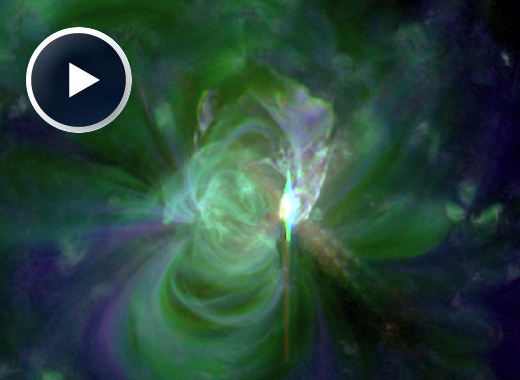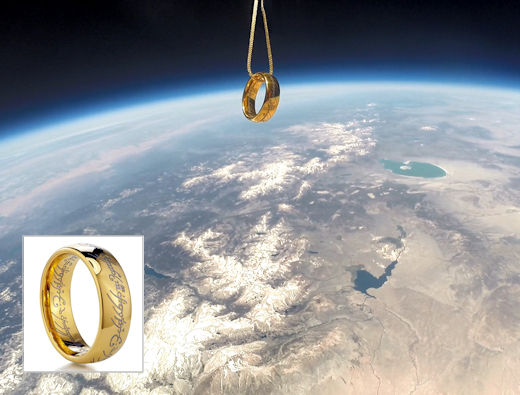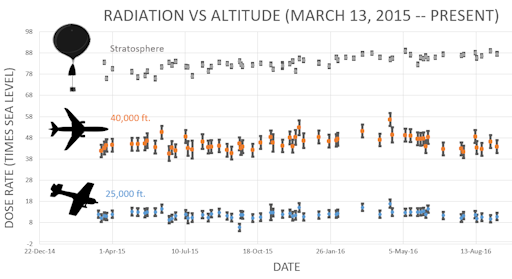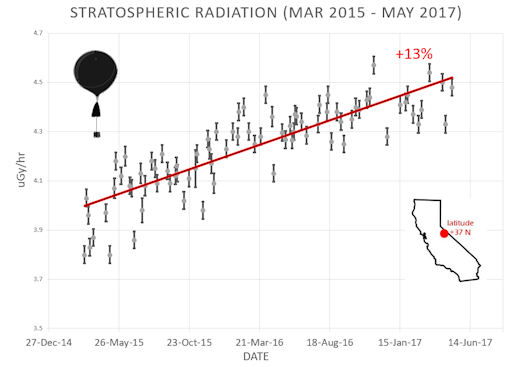 | | | Switch to: Europe, USA, New Zealand, Antarctica Credit: NOAA/Ovation  Planetary K-index Planetary K-index
Now: Kp= 1 quiet
24-hr max: Kp= 1 quiet
explanation | more data
Interplanetary Mag. Field
Btotal: 2.4 nT
Bz: 0.7 nT north
more data: ACE, DSCOVR
Updated: Today at 2350 UT  Coronal Holes: 21 Jun 18 Coronal Holes: 21 Jun 18 
Solar wind flowing from this northern coronal hole could graze Earth's magnetic field on June 23-24. Credit: SDO/AIA  Noctilucent Clouds The season for northern noctilucent clouds is beginning now. Check here daily for the latest images from NASA's AIM spacecraft. Switch view: Europe, USA, Asia, Polar Updated at: 06-21-2018 17:55:08 Noctilucent Clouds The season for northern noctilucent clouds is beginning now. Check here daily for the latest images from NASA's AIM spacecraft. Switch view: Europe, USA, Asia, Polar Updated at: 06-21-2018 17:55:08  SPACE WEATHER
NOAA Forecasts | | Updated at: 2018 Jun 21 2200 UTC FLARE | 0-24 hr | 24-48 hr | CLASS M | 05 % | 05 % | CLASS X | 01 % | 01 % |  Geomagnetic Storms: Geomagnetic Storms:
Probabilities for significant disturbances in Earth's magnetic field are given for three activity levels: active, minor storm, severe storm Updated at: 2018 Jun 21 2200 UTC Mid-latitudes | 0-24 hr | 24-48 hr | ACTIVE | 10 % | 10 % | MINOR | 01 % | 01 % | SEVERE | 01 % | 01 % | High latitudes | 0-24 hr | 24-48 hr | ACTIVE | 15 % | 15 % | MINOR | 20 % | 20 % | SEVERE | 15 % | 10 % | | | |  | | | | | | | | | | | All-inclusive Northern Lights trips in Tromsø, Norway. Small groups, big experiences! Highly qualified guides ensure unique and unforgettable adventures with a personal touch. Visit Explore the Arctic | | | MARTIAN DUST STORM GOES GLOBAL: It's official: A massive dust storm on Mars is now a global event, according to NASA. The storm swallowed NASA's Opportunity rover in early June, silencing the solar powered robot. Two weeks later the dust cloud has encircled all of Mars. NASA's nuclear-powered Curiosity rover is still functioning and reports that the opacity of the air doubled over the weekend, setting a new record for airborne dust. Stay tuned for updates. SOLAR MINIMUM SUNSPOT: During the past 24 hours, sunspot AR2715 has almost quadrupled in size, growing two dark cores larger than Earth. The active region is now crackling with low-level solar flares such as this C2-class explosion recorded by NASA's Solar Dynamics Observatory at 01:15 UT on June 21st: 
A pulse of extreme ultraviolet radiation from the flare briefly ionized the top of Earth's atmosphere above the Pacific Ocean (map), causing a shortwave radio brownout at frequencies below 10 MHz. People who might have noticed the disturbance include mariners and ham radio operators. This is a "Solar Minimum sunspot." In recent months, sunspot numbers have plummeted as the solar cycle shifts toward a deep minimum. On more than half of the days so far in 2018, the face of the sun has been completely blank without any sunspots at all. Even during Solar Minimum, however, big sunspots pop up from time to time--hence, AR2715. We will monitor this region carefully and post frequent updates about its growing potential for flares. Free: Solar Flare Alerts. Realtime Space Weather Photo Gallery ONE RING TO RULE THE STRATOSPHERE: Today, the students of Earth to Sky Calculus are in New Zealand preparing to launch a trio of cosmic ray balloons over Earth's 8th continent. But first... on June 12th they launched a ring of power to the stratosphere. Here it is floating 33 km above the Sierra Nevada mountains of central California: 
You can have one for $119.95. The students are selling these Tolkien-inspired rings as a fundraiser for their trip. They are made of golden-colored tungsten and inscribed with the authentic Mordor script of the One Ring. Buy one now, and we will fly it again for you over Hobbiton, located in the North Island of New Zealand where our cosmic ray balloons will be released. Just note "Please fly it again!" in the comments section at checkout. Each golden ring comes with a greeting card showing the ring in flight and telling the story of its journey to the edge of space. Sales support the Earth to Sky Calculus cosmic ray ballooning program and hands-on STEM research. Far Out Gifts: Earth to Sky Store
All proceeds support hands-on STEM education
Realtime Aurora Photo Gallery
Realtime Noctilucent Cloud Photo Gallery Every night, a network of NASA all-sky cameras scans the skies above the United States for meteoritic fireballs. Automated software maintained by NASA's Meteoroid Environment Office calculates their orbits, velocity, penetration depth in Earth's atmosphere and many other characteristics. Daily results are presented here on Spaceweather.com. On Jun. 21, 2018, the network reported 8 fireballs.
(8 sporadics)  In this diagram of the inner solar system, all of the fireball orbits intersect at a single point--Earth. The orbits are color-coded by velocity, from slow (red) to fast (blue). [Larger image] [movies] Potentially Hazardous Asteroids ( PHAs) are space rocks larger than approximately 100m that can come closer to Earth than 0.05 AU. None of the known PHAs is on a collision course with our planet, although astronomers are finding new ones all the time. On June 21, 2018 there were 1912 potentially hazardous asteroids.
 | Recent & Upcoming Earth-asteroid encounters: | Asteroid | Date(UT) | Miss Distance | Velocity (km/s) | Diameter (m) | | 2018 LN4 | 2018-Jun-16 | 16.5 LD | 14.6 | 64 | | 2018 MZ4 | 2018-Jun-16 | 0.5 LD | 9.8 | 6 | | 2018 LF1 | 2018-Jun-16 | 15.6 LD | 14 | 47 | | 2018 LD4 | 2018-Jun-17 | 14.8 LD | 9.3 | 39 | | 2018 KC3 | 2018-Jun-19 | 14.6 LD | 8.8 | 86 | | 2018 MT6 | 2018-Jun-19 | 12.6 LD | 6.3 | 22 | | 2018 LA6 | 2018-Jun-19 | 10.2 LD | 11 | 16 | | 2018 MK | 2018-Jun-20 | 7.5 LD | 17.1 | 54 | | 2018 MJ5 | 2018-Jun-21 | 11.7 LD | 8.2 | 15 | | 2018 MA | 2018-Jun-21 | 19.3 LD | 16.6 | 48 | | 2018 LX5 | 2018-Jun-21 | 5.2 LD | 11.7 | 32 | | 2018 LS5 | 2018-Jun-21 | 6.5 LD | 9 | 16 | | 2017 YE5 | 2018-Jun-21 | 15.6 LD | 15.5 | 513 | | 467309 | 2018-Jun-23 | 17.9 LD | 14 | 355 | | 441987 | 2018-Jun-24 | 7.3 LD | 12.6 | 178 | | 2018 LD3 | 2018-Jun-24 | 19.8 LD | 14.2 | 68 | | 2018 MX4 | 2018-Jun-27 | 5.5 LD | 8 | 15 | | 2018 LN2 | 2018-Jun-28 | 10.5 LD | 9.4 | 87 | | 2018 LR3 | 2018-Jun-29 | 6 LD | 3.8 | 20 | | 2018 LT6 | 2018-Jul-01 | 11.6 LD | 13 | 126 | | 2018 LJ1 | 2018-Jul-01 | 13.9 LD | 2.7 | 18 | Notes: LD means "Lunar Distance." 1 LD = 384,401 km, the distance between Earth and the Moon. 1 LD also equals 0.00256 AU. MAG is the visual magnitude of the asteroid on the date of closest approach. | | Cosmic Rays in the Atmosphere |
Readers, thank you for your patience while we continue to develop this new section of Spaceweather.com. We've been working to streamline our data reduction, allowing us to post results from balloon flights much more rapidly, and we have developed a new data product, shown here: 
This plot displays radiation measurements not only in the stratosphere, but also at aviation altitudes. Dose rates are expessed as multiples of sea level. For instance, we see that boarding a plane that flies at 25,000 feet exposes passengers to dose rates ~10x higher than sea level. At 40,000 feet, the multiplier is closer to 50x. These measurements are made by our usual cosmic ray payload as it passes through aviation altitudes en route to the stratosphere over California. What is this all about? Approximately once a week, Spaceweather.com and the students of Earth to Sky Calculus fly space weather balloons to the stratosphere over California. These balloons are equipped with radiation sensors that detect cosmic rays, a surprisingly "down to Earth" form of space weather. Cosmic rays can seed clouds, trigger lightning, and penetrate commercial airplanes. Furthermore, there are studies ( #1, #2, #3, #4) linking cosmic rays with cardiac arrhythmias and sudden cardiac death in the general population. Our latest measurements show that cosmic rays are intensifying, with an increase of more than 13% since 2015: 
Why are cosmic rays intensifying? The main reason is the sun. Solar storm clouds such as coronal mass ejections (CMEs) sweep aside cosmic rays when they pass by Earth. During Solar Maximum, CMEs are abundant and cosmic rays are held at bay. Now, however, the solar cycle is swinging toward Solar Minimum, allowing cosmic rays to return. Another reason could be the weakening of Earth's magnetic field, which helps protect us from deep-space radiation. The radiation sensors onboard our helium balloons detect X-rays and gamma-rays in the energy range 10 keV to 20 MeV. These energies span the range of medical X-ray machines and airport security scanners. The data points in the graph above correspond to the peak of the Reneger-Pfotzer maximum, which lies about 67,000 feet above central California. When cosmic rays crash into Earth's atmosphere, they produce a spray of secondary particles that is most intense at the entrance to the stratosphere. Physicists Eric Reneger and Georg Pfotzer discovered the maximum using balloons in the 1930s and it is what we are measuring today. | | The official U.S. government space weather bureau | | | The first place to look for information about sundogs, pillars, rainbows and related phenomena. | | | Researchers call it a "Hubble for the sun." SDO is the most advanced solar observatory ever. | | | 3D views of the sun from NASA's Solar and Terrestrial Relations Observatory | | | Realtime and archival images of the Sun from SOHO. | | | from the NOAA Space Environment Center | | | fun to read, but should be taken with a grain of salt! Forecasts looking ahead more than a few days are often wrong. | | | from the NOAA Space Environment Center | | | the underlying science of space weather |  | Reviews here can help you to pick up best memory foam mattresses. | | | These links help Spaceweather.com stay online. Thank you to our supporters! | | | | | | | | |  | |  |   | ©2017 Spaceweather.com. All rights reserved. This site is penned daily by Dr. Tony Phillips. | |

